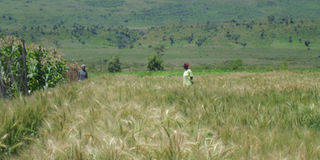Tips for growing wheat

Farmers have been encouraged to grow more wheat and meet the local demand. PHOTO by Lominda Afedraru
Wheat, also known as Tritium aestivum, is a cereal crop which belongs to the grass family of poaceae. The plant is one of the most traded agricultural produce globally since it is nutritive.
In Africa the crop is mainly grown as raw material for bakery industry on a relatively small scale.
In spite of its key role in combating hunger and malnutrition challenges, the grain is facing a threat from climate change challenges such as prolonged drought and over flooding farm lands. Other challenges include pests that invade farm fields. The crops’ vital contribution to the human diet and farmers livelihoods makes it central to the conversation about sustainability of rural environment and biodiversity in order to achieve food security for the growing population. As such more than 800 scientists majoring in wheat breeding across the world have gathered in Saskatoon, Canada for the International Wheat Congress to discuss ways of how farmers can adopt upcoming technologies to improve wheat yields across the globe.
Land preparation
Dr Martin Kropff, the director general of the International Maize and Wheat Improvement Centre (CIMMYT), notes that it is important for farmers to plough the land twice and make it fine for easy planting.
“It is important to observe the planting season and this is usually at the onset of the rain season,” says Dr Kropff who is also an agronomist.
For optimum production it is important for famers to establish a stand with no less than 1.5 million seedlings per acre. Some farmers prefer broadcasting the seed but the right spacing is 2cm by 2.5cm. If the germination percentage for wheat seed lot is 90 per cent, you must plant nearly 1.7 million seed per acre. For farmers who can afford to purchase fertiliser it is advised they use NPK which is adequate for wheat growth but other fertiliser such as Urea and DAP can also be used. Framers are required to apply fertiliser rate as per factory instruction.
Wheat varieties
It is important to choose the right variety and the case of Ethiopia, farmers are growing paron76 which is early maturing and tolerant to drought and King bird which has same characteristics. For the case of Uganda the recently released varieties are advisable and they include Naro wheat 1, 2, and 3. These varieties were released in 2015. They are resistant to UG99, yellow rust and leaf rust and high yielding with yield rate of 2.5 – 3 tonnes per hectare. For optimum production, you want to establish a stand with no less than 1.5 million seedlings to the acre. If the germination percentage for your wheat seed lot is 90 per cent, you must plant nearly 1.7 million seed per acre in order to have 1.5 million seedlings.
Since seed size can vary considerably for wheat, it is important to calibrate your drill for each seed lot you use in order to ensure you are always meeting your seed rate goal.
Once you start planting, periodically look behind your drill to make sure it is delivering the number of seeds per foot of row that you want.
Farmers who can afford application of herbicides may do so at the onset of ploughing. Choose the correct herbicide and make sure you apply it at the optimum time to get maximum protection from yield-robbing weeds.
Crop rotation
Crop rotation is likely the single best management practice to follow for any crop. Continuous wheat promotes increased susceptibility to wheat diseases.
Disease management
The best disease management practice occurs when you select your varieties.
“A farmer must chose those that have been rated resistant to moderately for the wheat diseases you may experience during the season,” says Dr Kropff. You can also scout your crop periodically during the season to know what is happening. Be prepared to use a fungicide if needed. Timing of fungicide applications is often critical. To provide protection against the various fungal leaf diseases, it is very important to protect the flag leaf. Some of the common diseases include wheat rust, fusarium head blight and UG99.
Harvest management
Timely harvest is the best insurance to realise optimum return and make sure your combine harvestor is set properly so that you thresh and clean the crop well. Avoid leaving excess amount of the crop in the field by having fan speed and sieves set appropriately and minimise losses.
Get it quick
To grow a good crop of wheat, one needs Shs180,000 for leasing land, Shs100,000 for ploughing and Shs90,000 for two sets of harrowing. Another Shs60,000 for planting, Shs100,000 for the fertiliser and Shs150,000 for seed. Herbicides could take up to Shs350,000 depending on weather.
To break even, the buying price has to be at least Shs130,000.




